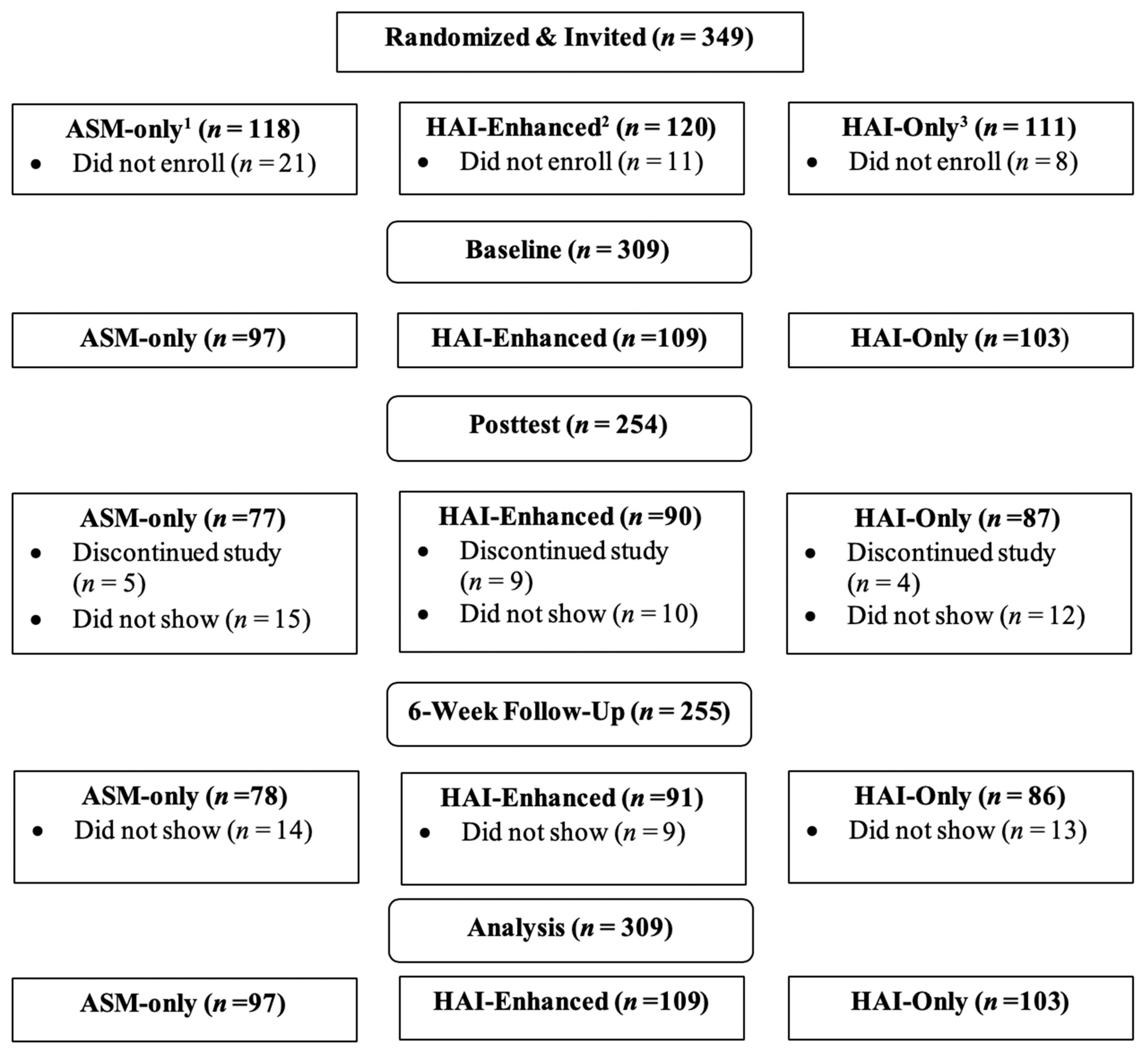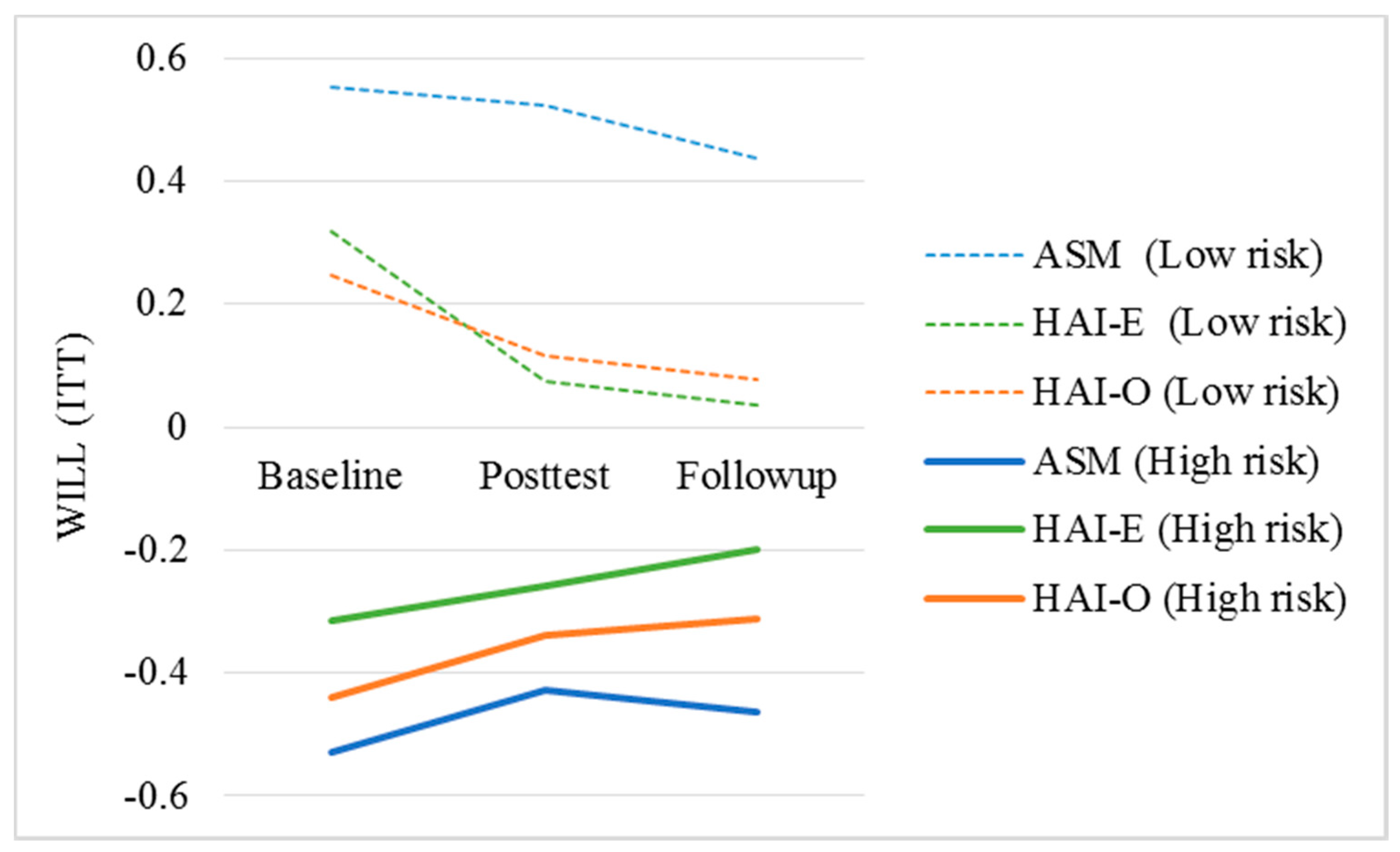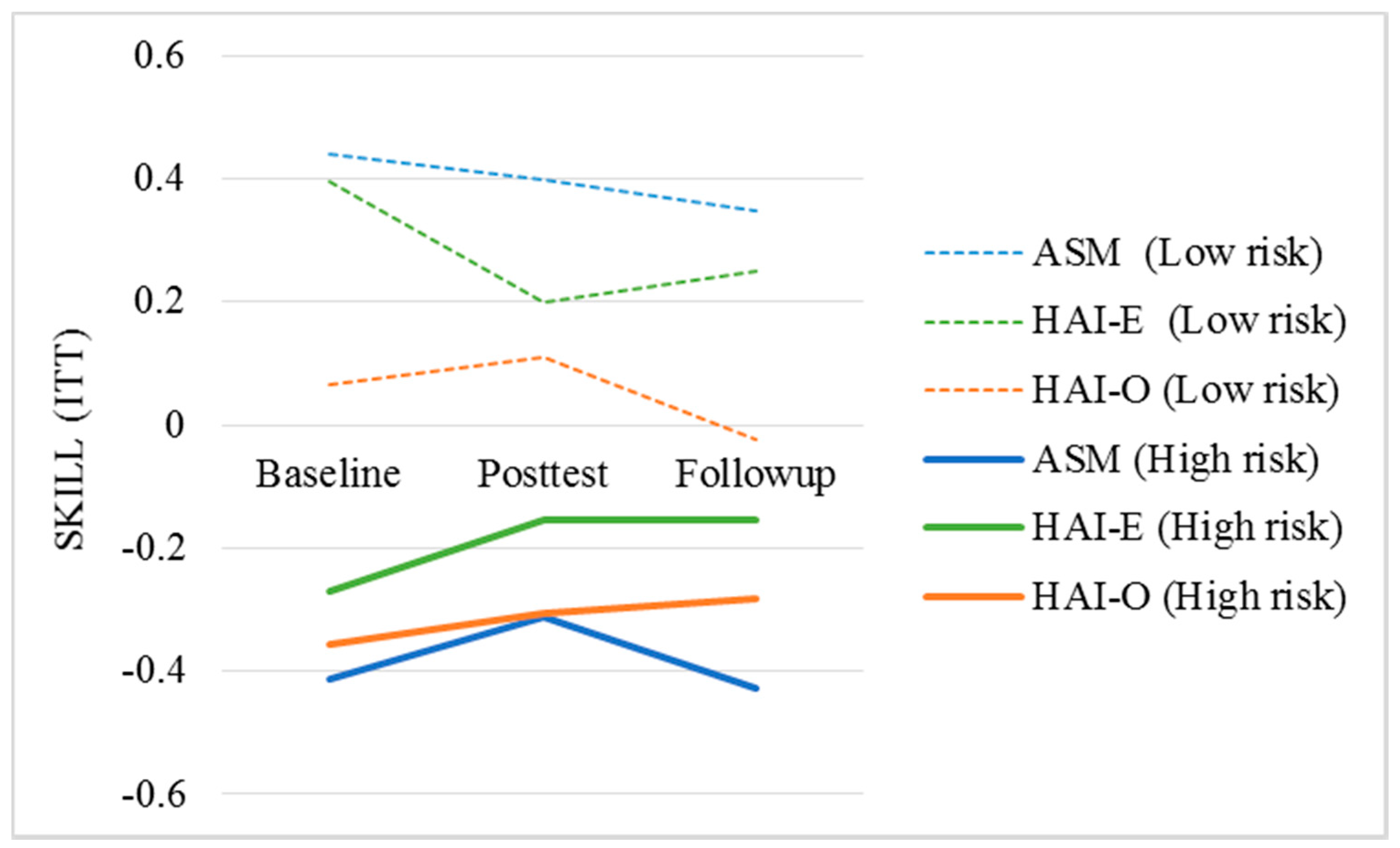Randomized Trial Examining Effects of Animal Assisted Intervention and Stress Related Symptoms on College Students’ Learning and Study Skills
Abstract
1. Introduction
1.1. Campus-Based Animal Assisted Interventions
1.2. Causal Evidence and Gaps in the Literature
1.3. Moderation of Risk Status
1.4. The Current Study: Effects of HAI on Student Learning Skills and Study Strategies
2. Materials and Methods
2.1. Recruitment
2.2. Measures
2.2.1. Dependent Variable: Learning and Study Strategies
2.2.2. Moderating Variable: Mood Risk Indicator
2.3. Treatment Conditions
Human–Animal Interaction
2.4. Description of Session Outlines, Activities, and Themes
2.4.1. Session 1: Academic Stress Management
2.4.2. Session 2: Motivation and Goal Setting
2.4.3. Session 3: Benefits of Sleep
2.4.4. Session 4: Test Anxiety
2.5. Program Fidelity
2.6. Power Calculation and Sample Size
2.7. Analytic Approach: Moderation of Treatment Effects by Levels of HAI and Risk Status
3. Results
3.1. Differences at Baseline by Condition and Risk Status
3.2. Predicting Effects of Treatment Condition and Mood Risk Status on WILL
3.3. Effects of Treatment Condition and Mood Risk Status on SELFREGULATION
3.4. Effects of Treatment Condition and Mood Risk Status on SKILL
4. Discussion
Strengths and Limitations
5. Conclusions
Author Contributions
Funding
Acknowledgments
Conflicts of Interest
References
- American College Health Association, American College Health Association-National College Health Assessment II: Undergraduate student executive summary Fall 2018; American College Health Association: Silver Spring, MD, USA, 2018.
- Oswalt, S.B.; Lederer, A.M.; Chestnut-Steich, K.; Day, C.; Halbritter, A.; Ortiz, D. Trends in college students’ mental health diagnoses and utilization of services, 2009–2015. J. Am. Coll. Health 2018, 1–11. [Google Scholar] [CrossRef]
- Eisenberg, D.; Lipson, S.K. The Healthy Minds Study 2018–2019 Data Report. Available online: https://healthymindsnetwork.org/wp-content/uploads/2019/09/HMS_national-2018-19.pdf (accessed on 18 October 2019).
- Henriques, G. The college student mental health crisis (Update). Psyschology Today. Available online: https://www.psychologytoday.com/us/blog/theory-knowledge/201811/the-college-student-mental-health-crisis-update (accessed on 18 October 2019).
- Jackson, L. Campuses are short on mental-health counselors. But they’ve got plenty of antidepressants. The Chronicle of Higher Education. Available online: https://www.chronicle.com/article/Campuses-Are-Short-on/246532 (accessed on 18 October 2019).
- Kane, W. Anxiety ‘epidemic’ brewing on college campuses. University of California News. Available online: https://news.berkeley.edu/2019/04/18/anxiety-epidemic-brewing-on-college-campuses-researchers-find/ (accessed on 18 October 2019).
- Kashdan, T.B. Is there an anxiety epidemic in today’s youth? Psychology Today. Available online: https://www.psychologytoday.com/us/blog/curious/201809/is-there-anxiety-epidemic-in-todays-youth (accessed on 18 October 2019).
- Center for Collegiate Mental Health. 2018 Annual Report. Available online: https://sites.psu.edu/ccmh/files/2019/01/2018-Annual-Report-1.30.19-ziytkb.pdf (accessed on 18 October 2019).
- Lipson, S.K.; Lattie, E.G.; Eisenberg, D. Increased rates of mental health service utilization by US college students: 10-year population-level trends (2007–2017). Psychiatr. Serv. 2019, 70, 60–63. [Google Scholar] [CrossRef] [PubMed]
- LeViness, P.; Bershad, C.; Gorman, K.; Braun, L.; Murray, T. The Association for University and College Counseling Center Directors Annual Survey—Public Version 2018; Association for University and College Counseling Center Directors: Indianapolis, IN, USA, 2018. [Google Scholar]
- Kroenke, K.; Spitzer, R.L.; Williams, J.B. The PHQ-9: validity of a brief depression severity measure. J. Gen. Intern. Med. 2001, 16, 606–613. [Google Scholar] [CrossRef] [PubMed]
- Spitzer, R.L.; Kroenke, K.; Williams, J.B.; Löwe, B. A brief measure for assessing generalized anxiety disorder: the GAD-7. Arch. Intern. Med. 2006, 166, 1092–1097. [Google Scholar] [CrossRef]
- Arria, A.M.; Caldeira, K.M.; Vincent, K.B.; Winick, E.R.; Baron, R.A.; O’Grady, K.E. Discontinuous college enrollment: Associations with substance use and mental health. Psychiatr. Serv. 2013, 64, 165–172. [Google Scholar] [CrossRef]
- Eisenberg, D.; Golberstein, E.; Hunt, J.B. Mental health and academic success in college. B. E. J. Econ. Anal. Policy 2009, 9, 40. [Google Scholar] [CrossRef]
- Bruffaerts, R.; Mortier, P.; Kiekens, G.; Auerbach, R.P.; Cuijpers, P.; Demyttenaere, K.; Green, J.G.; Nock, M.K.; Kessler, R.C. Mental health problems in college freshmen: Prevalence and academic functioning. J. Affect. Disord. 2018, 225, 97–103. [Google Scholar] [CrossRef] [PubMed]
- Cerqueira, J.J.; Mailliet, F.; Almeida, O.F.X.; Jay, T.M.; Sousa, N. The prefrontal cortex as a key target of the maladaptive response to stress. J. Neurosci. 2007, 27, 2781–2787. [Google Scholar] [CrossRef] [PubMed]
- Grant, K.E.; McMahon, S.D.; Carter, J.S.; Carleton, R.A.; Adam, E.K.; Chen, E.K. The influence of stressors on the development of psychopathology. In Handbook of Developmental Psychopathology; Lewis, M., Rudolph, K.D., Eds.; Springer: New York, NY, USA, 2014; pp. 205–223. [Google Scholar]
- Adam, E.K. Emotion—cortisol transactions occur over multiple time scales in development: implications for research on emotion and the development of emotional disorders. Monogr. Soc. Res. Child Dev. 2012, 77, 17–27. [Google Scholar] [CrossRef]
- Gunnar, M.R.; Adam, E.K. The hypothalamic–pituitary–adrenocortical system and emotion: current wisdom and future directions. Monogr. Soc. Res. Child Dev. 2012, 77, 109–119. [Google Scholar] [CrossRef]
- Obradović, J.; Boyce, W.T. Developmental psychophysiology of emotion processes. Monogr. Soc. Res. Child Dev. 2012, 77, 120–128. [Google Scholar] [CrossRef]
- Gunnar, M.; Quevedo, K. The Neurobiology of Stress and Development. Annu. Rev. Psychol. 2007, 58, 145–173. [Google Scholar] [CrossRef]
- Haggerty, J.M.; Mueller, M.K. Animal-assisted stress reduction programs in higher education. Innov. High. Educ. 2017, 42, 379–389. [Google Scholar] [CrossRef]
- Pendry, P.; Carr, A.M.; Roeter, S.M.; Vandagriff, J.L. Experimental trial demonstrates effects of animal-assisted stress prevention program on college students’ positive and negative emotion. Hum. -Anim. Interact. Bull. 2018, 6, 81–97. [Google Scholar]
- Grajfoner, D.; Harte, E.; Potter, L.; McGuigan, N. The effect of dog-assisted intervention on student well-being, mood, and anxiety. Int. J. Environ. Res. Public Health 2017, 14, 483. [Google Scholar] [CrossRef]
- Barker, S.B.; Barker, R.T.; McCain, N.L.; Schubert, C.M. A randomized cross-over exploratory study of the effect of visiting therapy dogs on college student stress before final exams. Anthrozoös 2016, 29, 35–46. [Google Scholar] [CrossRef]
- Crossman, M.K.; Kazdin, A.E.; Knudson, K. Brief unstructured interaction with a dog reduces distress. Anthrozoös 2015, 28, 649–659. [Google Scholar] [CrossRef]
- Binfet, J.-T. The effects of group-administered canine therapy on university students’ wellbeing: A randomized controlled trial. Anthrozoös 2017, 30, 397–414. [Google Scholar] [CrossRef]
- Pendry, P.; Vandagriff, J.L. Animal Visitation Program (AVP) Reduces Cortisol Levels of University Students: A Randomized Controlled Trial. AERA Open 2019, 5, 1–12. [Google Scholar] [CrossRef]
- Greenberg, M.T.; Abenavoli, R. Universal interventions: Fully exploring their impacts and potential to produce population-level impacts. J. Res. Educ. Eff. 2017, 10, 40–67. [Google Scholar] [CrossRef]
- Sin, N.L.; Lyubomirsky, S. Enhancing well-being and alleviating depressive symptoms with positive psychology interventions: A practice-friendly meta-analysis. J. Clin. Psychol. 2009, 65, 467–487. [Google Scholar] [CrossRef]
- Hofmann, S.G.; Sawyer, A.T.; Witt, A.A.; Oh, D. The effect of mindfulness-based therapy on anxiety and depression: A meta-analytic review. J. Consult. Clin. Psychology 2010, 78, 169–183. [Google Scholar] [CrossRef]
- Pendry, P.; Vandagriff, J.L.; Carr, A.M. Clinical depression moderates effects of animal-assisted stress prevention program on college students’ emotion. J. Public Ment. Health 2019, 18, 94–101. [Google Scholar] [CrossRef]
- Diamond, A. Effects of physical exercise on executive functions: Going beyond simply moving to moving with thought. Ann. Sports Med. Res. 2015, 2, 1011. [Google Scholar]
- Kuh, G.D.; Kinzie, J.L.; Buckley, J.A.; Bridges, B.K.; Hayek, J.C. What Matters to Student Success: A Review of the Literature; National Postsecondary Education Cooperative: Washington, DC, USA, 2006; Volume 8. [Google Scholar]
- Weinstein, B.J.; Palmer, D.R. Learning and Study Strategies Inventory (LASSI): Users Manual, 2nd ed.; H & H Publishing: Clearwater, FL, USA, 2002. [Google Scholar]
- Manual for the Beck Depression Inventory, 2nd ed.; The Psychological Corporation: San Antonio, TX, USA, 1996.
- Beck, A.T.; Steer, R.A. Beck Anxiety Inventory: Manual, 2nd ed.; The Psychiatric Association: San Antonio, TX, USA, 1993. [Google Scholar]
- de Beurs, E.; Wilson, K.A.; Chambless, D.L.; Goldstein, A.J.; Feske, U. Convergent and divergent validity of the Beck Anxiety Inventory for patients with panic disorder and agoraphobia. Depress. Anxiety 1997, 6, 140–146. [Google Scholar] [CrossRef]
- Meyer, T.J.; Miller, M.L.; Metzger, R.L.; Borkovec, T.D. Development and validation of the Penn State Worry Questionnaire. Behav. Res. Ther. 1990, 28, 487–495. [Google Scholar] [CrossRef]
- Brown, T.A.; Antony, M.M.; Barlow, D.H. Psychometric properties of the Penn state worry questionnaire in a clinical anxiety disorders sample. Behav. Res. Ther. 1992, 30, 33–37. [Google Scholar] [CrossRef]
- Cohen, S.; Kamarck, T.; Mermelstein, R. A global measure of perceived stress. J. Health Soc. Behav. 1983, 24, 385–396. [Google Scholar] [CrossRef] [PubMed]
- Pet Partners Therapy Pets & animal Assisted Activities. Available online: https://petpartners.org/ (accessed on 18 October 2019).
- Maujean, A.; Pepping, C.A.; Kendall, E. A systematic review of randomized controlled trials of animal-assisted therapy on psychosocial outcomes. Anthrozoos: A Multidiscip. J. Interact. People Anim. 2015, 28, 23–36. [Google Scholar] [CrossRef]
- Gee, N.R.; Griffin, J.A.; McCardle, P. Human–animal interaction research in school settings: Current knowledge and future directions. AERA Open 2017, 3. [Google Scholar] [CrossRef]
- Pendry, P.; Kuzara, S.; Gee, N.R. Evaluation of Undergraduate Students’ Responsiveness to a 4-Week University-Based Animal-Assisted Stress Prevention Program. Int. J. Environ. Res. Public Health 2019, 16, 3331. [Google Scholar] [CrossRef]




| Posttest | Follow-Up | |||||
|---|---|---|---|---|---|---|
| B | SE B | p-Value | B | SE B | p-Value | |
| (Constant) | 0.308 | 0.205 | 0.148 | 0.197 | 0.184 | 0.288 |
| HAI-E | −0.439 | 0.142 | 0.002 ** | −0.390 | 0.153 | 0.011 * |
| HAI-O | −0.406 | 0.147 | 0.006 ** | −0.356 | 0.157 | 0.024 * |
| Mood Risk | −0.934 | 0.151 | <0.001 *** | −0.880 | 0.162 | <0.001 *** |
| HAI-E * Mood Risk | 0.582 | 0.209 | 0.005 ** | 0.626 | 0.222 | 0.005 ** |
| HAI-O * Mood Risk | 0.481 | 0.208 | 0.021 * | 0.490 | 0.235 | 0.038 * |
| Attendance | 0.066 | 0.053 | 0.231 | 0.073 | 0.043 | 0.091 |
| Posttest | Follow-Up | |||||
|---|---|---|---|---|---|---|
| B | SE B | p-Value | B | SE B | p-Value | |
| (Constant) | 0.338 | 0.233 | 0.171 | 0.193 | 0.255 | 0.465 |
| HAI-E | −0.183 | 0.160 | 0.258 | −0.204 | 0.159 | 0.200 |
| HAI-O | −0.198 | 0.148 | 0.182 | −0.297 | 0.155 | 0.056 |
| Mood Risk | −0.638 | 0.160 | <0.001 *** | −0.710 | 0.173 | <0.001 *** |
| HAI-E * Mood Risk | 0.501 | 0.229 | 0.031 * | 0.630 | 0.233 | 0.007 ** |
| HAI-O * Mood Risk | 0.268 | 0.215 | 0.215 | 0.364 | 0.249 | 0.148 |
| Attendance | −0.006 | 0.065 | 0.931 | 0.041 | 0.064 | 0.539 |
| Posttest | Follow-Up | |||||
|---|---|---|---|---|---|---|
| B | SE B | p-Value | B | SE B | p-Value | |
| (Constant) | 0.301 | 0.184 | 0.105 | 0.126 | 0.261 | 0.640 |
| HAI-E | −0.195 | 0.171 | 0.258 | −0.089 | 0.156 | 0.569 |
| HAI-O | −0.288 | 0.170 | 0.092 | −0.368 | 0.157 | 0.019 * |
| Mood Risk | −0.704 | 0.184 | <0.001 *** | −0.756 | 0.170 | <0.001 *** |
| HAI-E * Mood Risk | 0.340 | 0.249 | 0.176 | 0.333 | 0.230 | 0.149 |
| HAI-O * Mood Risk | 0.288 | 0.238 | 0.227 | 0.499 | 0.228 | 0.029 * |
| Attendance | 0.031 | 0.052 | 0.564 | 0.068 | 0.062 | 0.293 |
© 2020 by the authors. Licensee MDPI, Basel, Switzerland. This article is an open access article distributed under the terms and conditions of the Creative Commons Attribution (CC BY) license (http://creativecommons.org/licenses/by/4.0/).
Share and Cite
Pendry, P.; Carr, A.M.; Gee, N.R.; Vandagriff, J.L. Randomized Trial Examining Effects of Animal Assisted Intervention and Stress Related Symptoms on College Students’ Learning and Study Skills. Int. J. Environ. Res. Public Health 2020, 17, 1909. https://doi.org/10.3390/ijerph17061909
Pendry P, Carr AM, Gee NR, Vandagriff JL. Randomized Trial Examining Effects of Animal Assisted Intervention and Stress Related Symptoms on College Students’ Learning and Study Skills. International Journal of Environmental Research and Public Health. 2020; 17(6):1909. https://doi.org/10.3390/ijerph17061909
Chicago/Turabian StylePendry, Patricia, Alexa M. Carr, Nancy R. Gee, and Jaymie L. Vandagriff. 2020. "Randomized Trial Examining Effects of Animal Assisted Intervention and Stress Related Symptoms on College Students’ Learning and Study Skills" International Journal of Environmental Research and Public Health 17, no. 6: 1909. https://doi.org/10.3390/ijerph17061909
APA StylePendry, P., Carr, A. M., Gee, N. R., & Vandagriff, J. L. (2020). Randomized Trial Examining Effects of Animal Assisted Intervention and Stress Related Symptoms on College Students’ Learning and Study Skills. International Journal of Environmental Research and Public Health, 17(6), 1909. https://doi.org/10.3390/ijerph17061909





